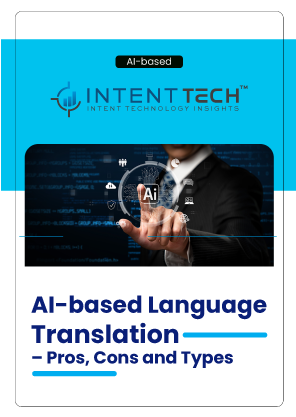or call: +1 (845) 347-8894

or call: +1 (845) 347-8894

Did you know AI-based language translation helped a leading e-commerce platform increase sales by more than 10%?
AI-based language translation is a helpful technology in today’s interconnected world. AI-powered multilocal SEO tools can break language barriers that hinder digital communication and collaboration using advanced algorithms. These algorithms adapt content to local needs and cultural nuances, rather than just focusing on literal translations. They accurately and efficiently translate text from one language to another serving a variety of purposes, including:
AI-powered language translation technology has made significant strides in recent years, becoming increasingly accurate and efficient. While it may not always achieve perfect translations, it can be a valuable tool for breaking down language barriers and fostering global understanding. As AI continues to evolve, we can expect even more impressive advancements in language translation, further bridging the gap between cultures and promoting global communication.

AI has become a household name today because of the increasing popularity of generative AI programs, such as OpenAI’s conversational chatbot ChatGPT and the stupendous AI image generator called Midjourney. With the advancements in big data, cloud computing, and other supporting technologies, Artificial Intelligence has become more accessible and easier to use, further fueling its growth. Many businesses are adopting AI to improve operational efficiency and decision-making. Overall, these efforts lead to gaining a competitive advantage in disruptive markets. Businesses deploy content translation and localization using AI translation systems to translate text, websites, and other content into multiple languages. Website translation is one of the best examples of using AI for businesses.
AI dubbing or AI translation is a type of machine translation that uses artificial intelligence to improve the accuracy and fluency of translations. Artificial intelligence-based systems are trained on large amounts of data, which allows them to learn the nuances of different languages and cultures. This makes them better at translating complex and idiomatic language, slang, and jargon.
Let us explore how Artificial Intelligence can help businesses translate their content especially if they want to localize their digital media.
76% of customers prefer to shop in their native language, while 40% will not buy from a site in another language.
Language translation can benefit businesses in many ways, including:

Let us understand what technologies are available in AI that help translate content.
MotionPoint’s Adaptive Translation™ technology combines the power of artificial intelligence, algorithmic translation, and translation memory to deliver exceptional results. This innovative approach provides human-quality translations at a fraction of the cost.
By leveraging these advanced technologies, users can:
The AI translation strategy involves the use of Neural Machine Translation (NMT) to optimize outcomes. NMT requires large amounts of training data and computational resources, but these requirements are becoming less of a barrier as the technology matures and the availability of data increases. NMT also struggles with rare or unknown words, but this is an area of active research, and several techniques can be used to improve the performance of NMT models in these cases.
MotionPoint’s Adaptive Translation™ model leverages the power of NMT to deliver high-quality translations that are affordable and accessible to businesses of all sizes.
It can be a valuable tool for businesses that need to translate text quickly and efficiently. However, it is important to be aware of the limitations of Artificial Intelligence before using it. Vendors such as MotionPoint commit to ultra-efficient workflows that minimize turnaround times and enhance productivity.
Speed: It can translate text much faster than human translators. This can be useful for translating large volumes of text, such as legal documents, technical manuals, or website content.
Cost-effectiveness: It can be more cost-effective than hiring human translators, especially for large translation projects.
Consistency: It can provide more consistent translations than human translators. This is because AI systems follow a set of rules and algorithms, which can help to reduce errors.
Quality: AI outcomes depend on the quality of data fed to train the models. While they aren’t perfect, bad data inputs can produce inaccurate or unnatural translations. This is especially true for more complex or creative translations.
Cultural differences: AI systems may not always understand the nuances of different cultures, which can lead to translations that are not appropriate or accurate for the target audience.
Limited languages: AI-based language translation models may not support all languages. The quality of the translation may vary depending on factors beyond the control of LLMs.
MotionPoint provides a solution to these limitations by combining AI with human intervention.
AI translation is a powerful tool that can be used to improve the speed, cost-effectiveness, and consistency of translation. However, it is important to use Artificial Intelligence in conjunction with human translators to ensure the quality of the translations. MotionPoint offers high-quality AI translation with the help of human experts. The result? High-quality accurate AI-based language translations delivered by native translators at a competitive price.
Want to learn more about MotionPoint and its solutions?
Please fill out our form, and someone from our team will contact you about your inquiry.
On-demand webinar: Get In Tune with Your Cloud Cyber Resilience Strategy
Webinar: Roadmap and Prioritization for 2025 Key Trends and Strategies
Blog Insights: Google Cloud’s Threat Horizons Report Identifies Risks to Serverless Environment
